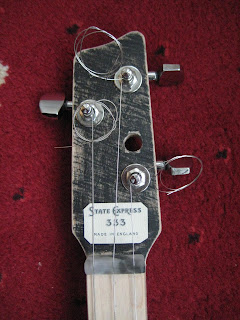cigar box guitar rewards
I mentioned in my last blog that some of the rewards of being involved in this cigar box guitar thing, have been the feedback and interaction with other people who have read or seen my postings. I mentioned a young lady (Lorraine from Ireland) who has taken the subject up as part of her college course and wanted to talk to me about it and use it as part of her thesis. This is fantastic. She phoned me to ask about intonation as she had built her first guitar and although it was playable, the intonation was wrong and the octave was turning up at the 14th fret instead of the 12th. After some questioning, we realised that she had had missed the point of having a bridge or saddle - effectively the anchorage of the strings at the tail end were her bridge, allowing it to be played still, but making the scale length too long. The addition of a saddle/bridge, set a few centi-metres forward should correct this. We had a good long chat and a few laughs and I really enjoyed talking to her. She has kindly allowed me to mention her and post a picture of her with her newly built, first cigar box guitar. Notice the knitted snowman in the bottom right with a big grin on his face. Looks like he's jamming along with an Irish tin whistle! Looking forward to seeing your next build Lorraine and maybe hearing you play it?
The way I normally set my neck, fretting, saddle position etc is quite simple. I have a long narrow piece of mdf with the fret positions drawn on (I always use the same short scale). I also have marks where the nut will be and where the bridge/saddle position should be (twice the distance of the nut to the 12th fret). Before I even start to cut the neck and because cigar boxes vary so much in size, I use the template against the box to size it up and make sure the bridge will be somewhere near where I want it (which is usually about 1/3 of the length of the box from the bottom edge). I can them see how long the whole neck need to be, allowing a few cms for the tail to stick out when using a through neck design and adding about 140mm to the top of the neck for the headstock. Also I can see where the 12th fret will be with regard to the top edge of the box. That's not so important - more for working out the aesthetics of how it will look and how many frets I might want in total. I always use a floating bridge rather than gluing it in place so I can adjust the intonation easily. Once you've built the guitar and strung it up you can place the bridge where it ought to be as a starter, then with a tuner, move it either backwards or forwards until you get the octave of the open string correct at the 12th fret. Hope this helps.






















